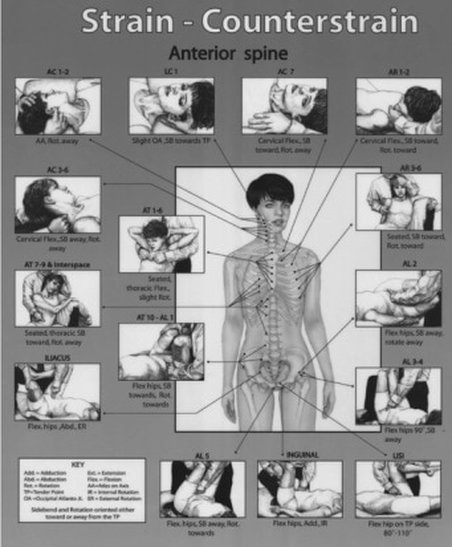|
Demonstrating anterior spine tender points and positioning. Obtained from The Jones Institute
|
How Strain and Counterstrain Works
Strain and Counterstrain is able to correct chronic muscle tension by correcting an overactive stretch reflex that exists in the painful muscle. [Reference: Stretch reflexes and Hoffman reflexes in patients with Achilles tendonitis, JAOA, 2006.] A normal muscle contracts as a result of communication with the central nervous system, but the overactive stretch reflex causes a muscle to contract constantly. This leads to a build up of neuroactive biochemicals or "waste products" in the muscle, perpetuating the chronic spasm causing the formation of a tender point or "trigger point." [Reference: Uncovering the biomechanical milieu of myofascial trigger points using in vivo microdyalysis: An application of muscle pain concepts to myofascial pain syndrome: Jay P. Shah, Journal of Body Work.] The Cause of Many Chronic Pain Syndromes Myofascial pain or "soft tissue problems" are responsible for a large percentage of chronic pain syndromes. It can occur in all areas of the body and presents as persistent tightness, pain or numbness/ tingling sensations. Myofascial pain cannot be detected by MRI, X-Ray or CT scan; however, trigger points can be diagnosed electrophysiologically by spontaneous electrical activity (SEA). Myofascial pain is distinctly different than fibromyalgia in which there is generalized soft tissue sensitivity in all areas of the body. Interestingly, patients with fibromyalgia often have some degree of myofascial pain and therefore still have significant pain relief following Counterstrain treatment. |
|
Treatments Are Pain Free
One of the main advantages to Strain and Counterstrain is that it is an "indirect" or pain free manual therapy technique. This means that you place patients into positions of ease and comfort instead of stretching them through pain and restriction. Also, Counterstrain's ability to reduce overactive stretch reflexes gives the technique excellent "carry over" or permanency. In essence, with this technique, the body corrects itself instead of being "forced" into correction. The muscular or musculoskeletal form of Counterstrain is targeted directly to the muscles of the human body and thus has many clinical applications. Post-operative muscle spasm, tension headaches, low back pain, neck pain, tennis elbow and sprained ankles are just a few examples of conditions that resond to this form of Strain and Counterstrain technique. (Information obtained and authorized by Brian Tuckey PT, OCS, JSCCI) Fascial Counterstrain for the Lymphatic SystemThe lymphatic system is responsible for draining and filtering fluids in the body. This tissue network rids the body of toxins and transport lymph, a fluid that contains white blood cells responsible for attacking diseases. Inflammation in the lymphatic system can be treated using FCS therapy in order to restore normal function.
Lymphatic DysfunctionBecause lymphatic vessels are also contractile, they are susceptible to dysfunction. Inflammation is common due to exposure to waste and toxins. Fascial Counterstrain therapy involves treating inflamed or dysfunction lymphatic vessels using the “tender point” identification method. FCS facilitates a restoration of the lymphatic pump system and the system can continue cleansing the body of toxins. Results can include pain relief and reduction in edema and visible inflammation.
FCS can be used to treat certain lymphatic dysfunctions such as lymphedema, chronic muscle disease, chronic bursitis, tendinitis, osteoarthritis, inflammatory bowel disease, and tinnitus. |
|
44025 Jefferson St., Ste 104
La Quinta, CA 92253 |
Phone: (760) 345-5453
Fax: (760) 345-7063 |
Hours of Operation:
Mon - Friday 7:30am - 6:00pm Closed weekends and major holidays |
Proudly powered by Weebly
